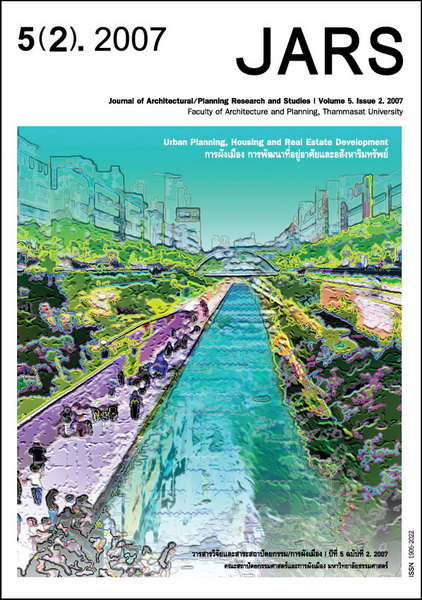Applications of Geographic Information System-GIS for Database Development of the Historic Buildings and Structures in the Municipality of Phuket
Main Article Content
Abstract
The Phuket Municipality, surrounding by a number of historic buildings and structures, was first
announced for the Cultural Environment Conservation and Historic Significance Area in 1994. Since then
the Municipality has continually conducted some development and conservation projects, but those
developments still lack database management systematically, particularly for supporting conservation
planning and management. As a consequence, the Geographic Information System (GIS) has been
applied in the Municipality’s database management system for historic buildings and structures, linking
the components to the existing databases. The renovated database consists of two main layers. These
are historic buildings and historic structures, containing 401 and 12 sites respectively. All of the sites are
required to meet some qualifications of the values, by which is applied to both layers, including building
character, cultural value, authenticity, building condition and threat. In addition, the historic structures
are divided into five categories i.e. monuments, bridges, circles, cemeteries and shrines. The database
can still be developed and brought up to date, while it can complement with other databases advanced
by the municipality to create its own effective tools to facilitate analysis for local administration and
development.
Downloads
Article Details

This work is licensed under a Creative Commons Attribution-NonCommercial-NoDerivatives 4.0 International License.
All material is licensed under the terms of the Creative Commons Attribution 4.0 International (CC-BY-NC-ND 4.0) License, unless otherwise stated. As such, authors are free to share, copy, and redistribute the material in any medium or format. The authors must give appropriate credit, provide a link to the license, and indicate if changes were made. The authors may do so in any reasonable manner, but not in any way that suggests the licensor endorses you or your use. The authors may not use the material for commercial purposes. If the authors remix, transform, or build upon the material, they may not distribute the modified material, unless permission is obtained from JARS. Final, accepted versions of the paper may be posted on third party repositories, provided appropriate acknowledgement to the original source is clearly noted.
References
Okabe, A. (Ed.). (2006). GIS-based studies in the humanities and social sciences. Boca Raton, FL: CRC Press.
Johnson, A. I., Petterson, C. B, & Fulton, J. L. (Eds.). (1992). Geographic information system (GIS) and mapping—practices and standards. Philadephia: American Society for Testing and Materials.
สรรค์ใจ กลิ่นดาว. (2542). ระบบสารสนเทศภูมิศาสตร์: หลักการเบื้องต้น. กรุงเทพฯ: สำนักพิมพ์มหาวิทยาลัยธรรมศาสตร์.
Schuurman, N. (2004). GIS: A short introduction. Malden, MA: Blackwell Publishing.
พรภัทร อธิวิทวัส และสุวดี ทองสุกปลั่ง. (2549). การวิเคราะห์ปัจจัยทางกายภาพที่มีอิทธิพลต่อศักยภาพทางพื้นที่เพื่อรองรับการตั้งถิ่นฐานและการพัฒนาความเป็นเมืองในจังหวัดสมุทรสาคร นครปฐม สมุทรสงคราม เพชรบุรี และอำเภอหัวหิน จังหวัดประจวบคีรีขันธ์ โดยใช้วิธี Potential Surface Analysis (PSA). วารสารวิจัยและสาระสถาปัตยกรรม/การผังเมือง, 4, 35-50.
คณะสถาปัตยกรรมศาสตร์และการผังเมือง มหาวิทยาลัยธรรมศาสตร์. (2549). โครงการปรับปรุงระบบฐานข้อมูลอาคารและสิ่งก่อสร้างที่มีคุณค่าทางประวัติศาสตร์ ตามโครงการพัฒนาและอนุรักษ์ในเขตสิ่งแวดล้อมศิลปกรรม ย่านการค้าเมืองเก่าภูเก็ต (รายงานฉบับสมบูรณ์). ปทุมธานี: ผู้แต่ง.
Horayangkura, V. (2005). The future of cultural heritage conservation amid urbanization in Asia: Constraints and prospects. Journal of Architectural/Planning Research and Studies, 3, 69-83.
Paul, B. (1998). GIS and cultural resource management: A manual for heritage managers. Bangkok, Thailand: Keen Publishing.


